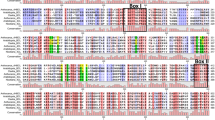Abstract
Cinnamic acid 4-hydroxylase (EC 1.14.13.11), a cytochrome P450-dependent hydroxylase was for the first time characterized from a hornwort, Anthoceros agrestis Paton (Anthocerotaceae). In suspension cultures of A. agrestis up to 5% of the dry weight was accumulated as rosmarinic acid, a natural product commonly known from higher plants (e.g. species of the Lamiaceae and Boraginaceae). Cinnamic acid 4-hydroxylase is involved in the biosynthesis of rosmarinic acid. The participation of cytochrome P450 was demonstrated by the inhibition of hydroxylase activity by cytochrome c and the inhibition of cinnamic acid hydroxylation in a CO-containing atmosphere, which is partially released by illumination with blue light. The apparent K m values were determined to be at 60 μM and 5 μM for NADPH and cinnamic acid, respectively. A comparatively high hydroxylation activity was seen with NADH as electron donor. While the hydroxylase activity with NADPH was strongly inhibited by the competitive electron acceptor cytochrome c, the activity with NADH was less susceptible, indicating the possibility of different electron-transfer pathways.



Similar content being viewed by others
Abbreviations
- C4H:
-
cinnamic acid 4-hydroxylase
- DIECA:
-
sodium diethyldithiocarbaminate
- DTT:
-
dithiothreitol
- PAL:
-
phenylalanine ammonia-lyase
- RA:
-
rosmarinic acid
References
Binding H, Mordhorst G (1991) Gametophyte regeneration and apospory from archegoniate protoplasts under conditions devised for higher plants. Bot Acta 104:330–335
Bradford MM (1976) A rapid and sensitive method for the quantitation of microgram quantities of protein utilizing the principle of protein–dye binding. Anal Biochem 72:248–254
De Vetten N, ter Horst J, van Schaik HP, de Boer A, Mol J, Koes R (1999) A cytochrome b5 is required for full activity of flavonoid 3′,5′ hydroxylase, a cytochrome P450 involved in the formation of blue flower colours. Proc Natl Acad Sci USA 96:778–784
Durst F (1991) Biochemistry and physiology of plant cytochrome P-450. In: Ruckpaul K, Rein H (eds) Frontiers in biotransformation, vol 4: Microbial and plant cytochrome P-450: biochemical characterization, genetic engineering and practical implications. Taylor and Francis, London, pp 191–232
Friederich S, Rueffer M, Asakawa Y, Zenk MH (1999) Cytochromes P450 catalyze the formation of marchantins A and C in Marchantia polymorpha. Phytochemistry 52:1195–1202
Gamborg OL, Miller RA, Ojima K (1968) Nutrient requirements of suspension cultures of soybean root cells. Exp Cell Res 50:151–158
Gertlowski C, Petersen M (1993) Influence of the carbon source on growth and rosmarinic acid production in suspension cultures of Coleus blumei. Plant Cell Tissue Org Cult 34:183–190
Lewis NG, Davin LB (1994) Evolution of lignan and neolignan biochemical pathways. In: Nes D (ed) Evolution of natural products (ACS Symposium Series 562). American Chemical Society, Washington DC, pp 202–246
Petersen M (1997) Cytochrome P450-dependent hydroxylation in the biosynthesis of rosmarinic acid in Coleus. Phytochemistry 45:1165–1172
Petersen M, Alfermann AW (1988) Two new enzymes of rosmarinic acid biosynthesis from cell cultures of Coleus blumei: hydroxyphenylpyruvate reductase and rosmarinic acid synthase. Z Naturforsch 43c:501–504
Petersen M, Häusler E, Karwatzki B, Meinhard J (1993) Proposed biosynthetic pathway for rosmarinic acid in cell cultures of Coleus blumei. Planta 189:10–14
Russell DW (1971) The metabolism of aromatic compounds in higher plants. X. Properties of the cinnamic acid 4-hydroxylase of pea seedlings and some aspects of its metabolic and developmental control. J Biol Chem 246:3870–3878
Russell DW, Conn EE (1967) The cinnamic acid 4-hydroxylase of pea seedlings. Arch Biochem Biophys 122:256–258
Sitte P, Weiler EW, Kadereit JW, Bresinsky A, Körner C (2002) Strasburger—Lehrbuch der Botanik für Hochschulen. Spektrum, Heidelberg, Berlin
Takeda R, Hasegawa J, Sinozaki K (1990a) The first isolation of lignans, megacerotonic acid and anthocerotonic acid, from non-vascular plants, Anthocerotae (hornworts). Tetrahedron Lett 31:4159–4162
Takeda R, Hasegawa J, Sinozaki K (1990b) Phenolic compounds from Anthocerotae. In: Zinsmeister HD, Mues R (eds) Bryophytes. Their chemistry and chemical taxonomy. Oxford Science Publications, Oxford, pp 201–207
Trennhäuser F (1992) Phytochemische Untersuchung und in vitro Kultur ausgewählter Vertreter der Anthocerotopsida. PhD thesis, University of Saarbrücken, Germany
Werck-Reichhardt D (1995) Cytochrome P450 in phenylpropanoid metabolism. In: Kingsley N (ed) Drug metabolism and drug interactions, vol 12. Freund Publishing House, Tel Aviv, pp 221–243
West CA (1980) Hydroxylases, monooxygenases, and cytochrome P-450. In: Davies DD (ed) The biochemistry of plants, vol 2. Academic Press, New York, pp 317–367
Author information
Authors and Affiliations
Corresponding author
Rights and permissions
About this article
Cite this article
Petersen, M. Cinnamic acid 4-hydroxylase from cell cultures of the hornwort Anthoceros agrestis . Planta 217, 96–101 (2003). https://doi.org/10.1007/s00425-002-0960-9
Received:
Accepted:
Published:
Issue Date:
DOI: https://doi.org/10.1007/s00425-002-0960-9




